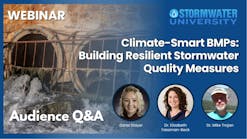About the author:
Mitchell Stocki is market development manager for HaloKlear, covering the eastern U.S. Stocki can be reach at [email protected] or 425.974.1918.
In 2012, Civil Site Constructors Inc. was tasked with cleaning up the storm water canals lining the runways at Tampa International Airport. These canals had filled with vegetation and debris and were no longer properly cleaning the storm water runoff that flows into Tampa Bay.
The project was massive, with three large sections that needed to be treated. Civil Site Constructors, working with Pure Polymer Solutions, had to clean approximately 12,313 cu yd of channel and 3,094 ft of embankment.
Initial Monitoring
Tampa Bay is a highly sensitive, high-profile body of water that is closely monitored by state regulators. Civil Site Constructors and Pure Polymer Solutions had to provide a solution that would guarantee against any harm to the aquatic and plant life in Tampa Bay. The initial results were troubling; in some sections of the project, the turbidity of the water effluent was 617—far above the 31.43 nephelometric turbidity units (NTU) required by the state regulators. These high NTU levels would have placed the contractor out of compliance, which could have led to fines. In addition, high turbidity water could have made its way to Tampa Bay, which is pristine in its clarity.
Pure Polymer Solutions works regularly with Civil Site Constructors and Florida Dewatering, which provides pumps that are used in dredging the canals, and recommended they use an all-natural bio-polymer called HaloKlear to treat the water and obtain the required NTU discharge.
Procedures and Results
HaloKlear and Pure Polymer Solutions worked together to evaluate various polymer technologies to find the best reaction with the influent water using the lowest, most economical dose. Dual Polymer System (DPS) was selected because of the all-natural properties; other polymer coagulants that were tested contained addition of inorganic metal salts to start the coagulation process. With DPS, there are no bio-accumulation concerns.
Forty-eight-hour settling allowance concluded that fresh water samples would settle without polymer addition, but would not meet storm water pollution prevention plan (SWPPP) guidelines. Replicated tests in salt water found that settling was greatly reduced without addition of polymers. Turbidity readings were 343 NTUs above maximum allowable SWPPP discharge limitations.
DPS optimization found that 100 ppm of liquid biopolymer-2101 and 150 ppm of LiquiFloc 1% (both HaloKlear technologies) would reduce influent turbidity well below SWPPP discharge limits in both freshwater and salt water. Because the project is situated adjacent to Tampa Bay and the project area is infiltrated by tidal flows within the project canals, DPS was prescribed for total suspended solids (TSS) reduction. DPS can be deployed via liquid injection or by current methods of a dry semi-passive model. Removal of TSS via sediment bag capture is optional, but was recommended here, as the project is so close to the Tampa Bay discharge point.
Site Operations
Current treatment operations consist of passive treatment within a 72-in. culvert pipe and a semi-passive treatment area through a 6-in. manifold discharging into a sediment bag. Both applications utilize the DPS dry biopolymer-2101 and GelFloc segmented socks.
Passive treatment operations treat a low-flow of 50 gpm average on dry days. Rain events can result in upwards of 150 gpm. This treatment utilizes one dry bio-polymer-2101 sock and one GelFloc sock in each of the two 72-in. culvert pipes. One hundred feet of pipe discharges into a tide-affected canal, which then discharges directly to Tampa Bay. Multiple species of fish gather at the treated discharge point. Samples taken at 10 ft, 20 ft and 30 ft have a no-detect residual chitosan test. There is no course filtration for sediment capture because of the influence of tidal flow, which would alter or carry away any filter media. Sediment is allowed to drop in the confines of a floating turbidity barrier. NTU samples taken at the discharge point are 12 NTUs at 10 ft from discharge; 5 NTUs at 20 ft from discharge; and 3 NTUs at 30 ft from discharge. Influent NTU readings are 644 NTUs nearest construction operations and 180 NTUs farthest from construction operations.
Semi-passive treatment operations treat an average flow of 250 gpm. Hours of operation vary with the amount of influent water collected at the source. Treatment can run eight hours or 24 hours, depending on the need. Final discharge from the sediment bag flows through a vegetation area and into a wetland. NTU at the influent averages in the 600s with rain events, down to 180 NTUs during dry conditions. NTU readings off the sediment bag average between 1.70 and 5 NTUs. Residual tests concluded a no-detect at the effluent collection point approximately 20 ft from the sediment bag.
Future Monitoring
Because this project is so large and will continue into the future, HaloKlear is providing new monitors to be used throughout the project that will automatically take readings every two minutes. The monitor is a compact Data Sonde for unattended monitoring, manufactured by YSI.
HaloKlear will provide data collected throughout the site to the U.S. Environmental Protection Agency (EPA), helping the EPA to eventually set national standards and guidelines for construction site storm water effluent.
This project is still in operation and continues to grow week to week. Additional weir tanks and a heavier dose of polymers will be added in sensitive areas in the coming weeks. The success of this project will affect how effluent will be treated on surrounding projects in the Tampa area. A nearby Air Force base is currently evaluating the results of these systems to use on an upcoming construction project.
Download: Here






